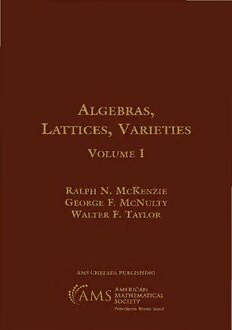
Algebras, Lattices, Varieties (The Wadsworth & Brooks/Cole Mathematics Series) PDF
380 Pages·1987·7.385 MB·English
Most books are stored in the elastic cloud where traffic is expensive. For this reason, we have a limit on daily download.
Preview Algebras, Lattices, Varieties (The Wadsworth & Brooks/Cole Mathematics Series)
Description:
Volume 1 is a leisurely paced introduction to general algebra and latticetheory. Besides the fundamental concepts and elementary results, it containssevera1 harder (but basic) results that will be required in later volumes and a finalchapter on the beautiful topic of unique factorization. This volume is essentiallyself-contained. We sometimes omit proofs, but-except in rare cases-only thosewe believe the reader can easily supply with the lemmas and other materials thatare readily at hand. It is explicitly stated when a proof has been omitted for otherreasons, such as being outside the scope of the book. We believe that this volumecan be used in severa1 ways as the text for a course. The first three chaptersintroduce basic concepts, giving numerous examples. They can serve as the textfor a one-semester undergraduate course in abstract algebra for honors students.(The instructor will probably wish to supplement the text by supplying moredetail on groups and rings than we have done.) A talented graduate student ofmathematics with no prior exposure to our subject should find these chapterseasy reading. Stiff resistance will be encountered only in $2.4-the proof of theDirect Join Decomposition Theorem for modular lattices of finite height-atightly reasoned argument occupying severa1 pages.In Chapter 4, the exposition becomes more abstract and the pace somewhatfaster. Al1 the basic results of the general theory of algebras are proved in thischapter. (There is one exception: The Homomorphism Theorem can be found inChapter 1.) An important nonelementary result, the decomposition of a complementedmodular algebraic lattice into a product of projective geometries, isproved in $4.8. Chapter 4 can stand by itself as the basis for a one-semestergraduate course. (Nevertheless, we would advise spending severa1 weeks in theearlier chapters at the beginning of the course.) The reader who has masteredChapters 1-4 can confidently go on to Volume 2 without further preliminaries,since the mastery of Chapter 5 is not a requirement for the later material.Chapter 5 deals with the possible uniqueness of the factorization of analgebra into a direct product of directly indecomposable algebras. As examples,integers, finite groups, and finite lattices admit a unique factorization. The Jordannormal form of a matrix results from the unique decomposition of the representa- ltion module of the matrix. This chapter contains many deep and beautiful results.Our favorite is Bjarni Jónsson's theorem giving the unique factorization of finitealgebras having a modular congruence lattice and a one-element subalgebra(Theorem 5.4). Since this chapter is essentially self-contained, relying only on theDirect Join Decomposition Theorem in Chapter 2, a one-semester graduatecourse could be based upon it. We believe that it would be possible to get throughthe whole volume in a year's course at the graduate level, although none of ushas yet had the opportunity to try this experiment.
See more
The list of books you might like
Most books are stored in the elastic cloud where traffic is expensive. For this reason, we have a limit on daily download.
